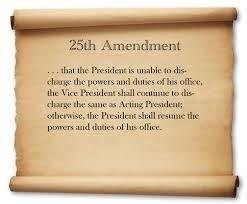US twenty fifth amendments- new policies
 The Twenty-fifth Amendment (Amendment XXV) to the United States Constitution deals with succession to the Presidency and establishes procedures both for filling a vacancy in the office of the Vice President as well as responding to Presidential disabilities.
The Twenty-fifth Amendment (Amendment XXV) to the United States Constitution deals with succession to the Presidency and establishes procedures both for filling a vacancy in the office of the Vice President as well as responding to Presidential disabilities.
That clause was unclear regarding Presidential succession and inability; it did not state who had the power to declare a President incapacitated.[1] Also, it did not provide a mechanism for filling a Vice Presidential vacancy before the next Presidential election. The vagueness of this clause caused difficulties many times before the Twenty-fifth Amendment's adoption:
In 1841, President William Henry Harrison became the first U.S. President to die in office. Representative John Williams had previously suggested that the Vice President should become Acting President upon the death of the President.[4] John Tyler asserted that he had succeeded to the presidency, as opposed to only obtaining its powers and duties. He also declined to acknowledge documents referring to him as "Acting President". Although he felt his vice presidential oath negated the need for the presidential oath, Tyler was persuaded that being formally sworn-in would clear up any doubts about his right to the office. Having done so, he then moved into the White House and assumed full presidential powers. While he was often derided by opponents as "His Accidency",[5] Tyler's claim was not formally challenged, and both houses of Congress adopted a resolution confirming that Tyler was the tenth President of the United States, without any qualifiers.